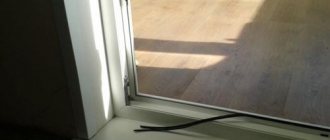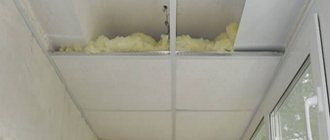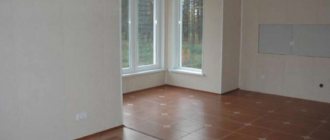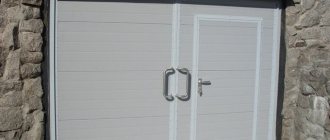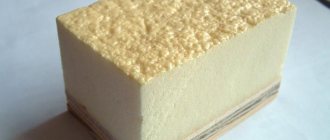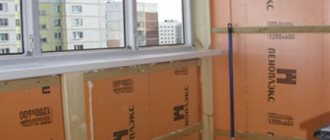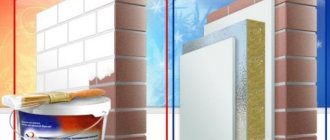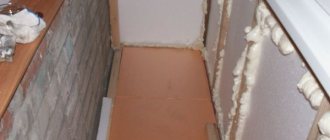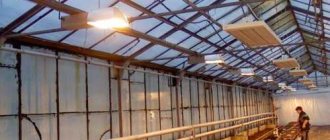Is it necessary to insulate a balcony with cold glazing?
Insulation of cold glazing is sometimes used, although usually this activity takes a lot of effort and time, but does not give the desired result, since in most cases it is carried out incorrectly. Before work, you should learn how to properly insulate a balcony, making it a comfortable room.
What glazing is considered cold?
Quite often, when purchasing an apartment, the owner is faced with the fact that it already has glazing.
Often, the developer does not use expensive materials and installs cold glazing without insulating the balcony in any way.
In this case, it may be important to replace cold glazing with warm glazing , which will significantly improve the final result, as it will help eliminate heat loss that occurs precisely through the window frames.
However, you can improve cold glazing. Most often it is aluminum frames. Aluminum itself has high thermal conductivity, so the room cools down quickly. Plastic double-glazed windows can also be cold.
Most often this is a problem with single-chamber structures. This type of glazing can protect against precipitation, wind, dust, but does not withstand frost well.
Therefore, insulating the cold glazing of a loggia or balcony plays a rather important role in creating a comfortable atmosphere in the house.
How to insulate a balcony with cold glazing?
Insulating cold glazing may not be beneficial, but it is very important to do it correctly; To insulate such a structure, you will need the following:
- Close and insulate any seams that you can find between the window frame and the wall.
- After this, you will need to seal all the cracks in the walls, special attention should be paid to the corners of the structure.
- Make insulation of the floor, walls, ceiling.
Frame for laying insulation on floors and walls, warm floors
Insulation can be external or internal.
If permission may be required for the exterior, since changes will be made to the external appearance of the building, then you can carry out the interior without collecting papers, since such insulation of cold glazing occurs without changing the facade. You can also insulate the structure from the inside on your own, without involving expensive specialists and without putting your life in danger when working at height.
How to insulate seams between frames?
Insulating a balcony without replacing cold glazing should begin with finishing all the seams of the structure, since most of the heat leaves through them and through them cold air enters from the street.
In addition, moisture can penetrate through the seams, which negatively affects the condition of the structure as a whole. Because of it, fungus, mold, and other unpleasant phenomena can form.
In order to get rid of cracks, you will have to do the following:
- Clean the seams from old paint, plaster, debris and foam. To do this, you can use a spatula whose width is 100 mm.
- Check for empty spaces or gaps. It is convenient to do this in sunny weather.
- The voids are filled with polyurethane foam, less often with cement mortar.
- After the foam has dried, which will take about a day, the excess is cut off and the joints themselves are sealed with a special waterproof tape.
- The seams can be covered with a layer of putty, and plastic strips can be installed. When insulating the side walls, finishing is not required at this stage.
Sealing cracks with construction foam
How to properly insulate a floor?
You should not ignore the insulation of the floor; most of the cold comes through it, therefore, by reliably insulating the surface, you can make the structure well protected from freezing. To do this you will need to do the following:
- Level the base: quite often the slabs are crooked, which causes the formation of hollows in which moisture accumulates. You can get rid of this by making a floor screed.
- Construction of sheathing. For this, a wooden beam 50x25 mm is used. Long beams are laid along the structure. The pitch of the transverse logs is usually 50-60 cm; the frame is assembled using self-tapping screws.
- After this, insulation is installed. You can use anything, for example, mineral wool or polystyrene foam.
- The insulation must be at least 50 mm. It must be placed in cells made of wood.
- It is advisable, but not necessary, to cover the structure with a waterproofing film.
- After this, the floor is sewn up. You can use a thick sheet of chipboard or plywood for this.
- The finishing layer can be laminate or linoleum.
Floor insulation with polystyrene foam and laminate covering
Insulation of walls and ceilings
After the floor insulation work is completed, you can work on the walls.
Insulating cold aluminum glazing will thus help contain the cold coming from the walls and ceiling, but will not create a completely airtight structure, since some of the heat will still escape through the frames and glass.
The work is carried out on the same principle as floor insulation: a wooden sheathing is created, the cells are filled with insulation, then the sheathing is installed, and plasterboard sheets can also be used.
If the fence is metal, then you will have to deal with its external decoration, otherwise the cold will still come in. You can use siding for this. In addition, you can replace the fence with a stone one. It is recommended to use lightweight material such as foam block.
Don't forget about the ceiling. Warm air will rise, so if the ceiling is not insulated, heat will escape through it. If the lower floors can simply insulate the slab located above them, then the upper floor will have to equip an insulated canopy.
It can be attached to the wall of the building or placed on columns.
Coating walls with thermal insulation
Is it worth changing the glazing?
Many users may wonder: why insulate a loggia with cold glazing? Insulation using the method described above will help to reliably protect the structure and improve its quality, however, such a balcony still cannot be called warm.
Most of the heat will escape through aluminum frames or insufficiently thick double glazed windows in the case of plastic windows.
Therefore, if you need a really warm balcony that can be heated and which can be made part of the living space, you will need to completely replace the cold façade glazing with a warm one.
How does the glazing replacement work proceed?
Any work is carried out in several stages. This procedure is performed like this:
- Calculation of the mass that the parapet can withstand. You should not use glazing that is too heavy, as this may lead to the collapse of the structure.
- Cold windows are quite easy to remove: to do this, you need to cut off the mounting foam, pull out the glass, and disconnect other fasteners, if any. After this, the frame can be pulled out.
- New windows are being installed. It is recommended to use plastic ones with double glazing. They usually don’t weigh very much, but they retain heat well.
- If you had panoramic cold glazing, then you can install plastic windows from the floor or build a parapet from lightweight materials, such as gas block.
- You can choose any windows according to the opening method, it depends only on how much free space is on your balcony.
- If it is impossible to install windows with a thick double-glazed unit, you can install energy-saving glass on a thin one; they will help retain heat without increasing the weight of the structure.
Which insulation to choose?
For external insulation, you can use the same material that is proposed for internal insulation. However, some types of insulation are afraid of moisture, while others are not.
- Mineral wool is a popular, relatively inexpensive insulation material that can retain heat well, but it requires reliable waterproofing. Wet wool will lose its properties, fungus may appear in it or insects may appear in it, so it is important to immediately make a hydro- and vapor barrier, cover the facade and the wool with a material that does not allow moisture to pass through. Mineral wool is not very convenient to work with. This is a soft material that tears easily, does not hold its shape, and therefore requires reliable lathing. It is worth noting that you need to use a mask, goggles and protective gloves, since cotton wool fibers strongly irritate the skin and mucous membranes.
- Foam plastic, penoflex, etc. - these are similar materials that can be classified into the same group. They are made from artificial fibers and are available in sheet form. Polystyrene foam is quite durable, does not crumble, insulates heat well and does not allow air to pass through at all, so it can be used without a vapor barrier. The material is easy to attach; no protective equipment is required. It is not afraid of water, but is quite fragile and cannot withstand strong mechanical stress. Birds love to eat it, even though it is not edible. That is why the sheets should be covered with cladding, like the previous option.
- Polyurethane foam can also be used as insulation. It fills all the cracks well, sticks to almost any surface, quickly gains volume and hardens, becoming hard. However, such insulation is destroyed under the influence of ultraviolet radiation, does not react well to moisture, turns yellow over time, and loses its properties if it is not protected with a solid material that does not allow moisture and light to pass through. Siding is good for finishing.
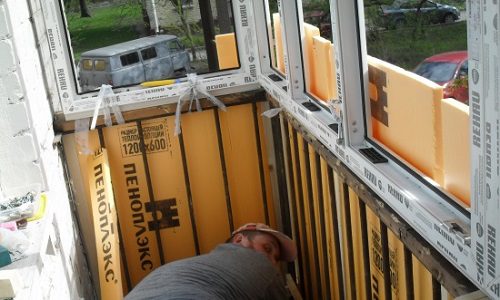
Is it worth insulating cold balconies and loggias - floors, walls, ceilings?
An uninsulated balcony cannot be used comfortably at any time of the year, unlike a warm one, and therefore more and more owners of such structures want to insulate this area, providing themselves with additional square meters.
When it comes to insulating a cold-type balcony or loggia, even those ignorant of “construction and renovation” wonder whether it is worth carrying out work on insulating a cold balcony in this case.
To begin with, I would like to clarify what the concept of a “cold balcony” actually is.
What does a cold balcony mean?
A cold balcony or cold glazing involves the installation of aluminum or PVC windows with single glass (sometimes single-chamber double-glazed windows). Aluminum, due to its high thermal conductivity, is not able to maintain a comfortable above-zero temperature on the balcony.
PVC profiles consisting of 3 or fewer chambers also do not provide effective heat conservation. In addition, the installation width of such frames is less than 60 mm, and therefore it is not possible to install a double-chamber warm double-glazed window.
The cold type of balconies also includes frameless Finnish glazing, which lacks the usual window frames.
The main purpose of cold glazing
– this is protection from wind, drafts, precipitation and dust, as well as the opportunity to beautifully and modernly decorate this area at a relatively low cost. “Cold” windows will not be able to make your balcony or loggia warm, because they are not based on multi-chamber double-glazed windows with energy-saving properties, and the profile is not able to withstand low temperatures.
In this case, you should figure out whether it is worth insulating a balcony with cold glazing, how rational and economically profitable it is.
Is it necessary to insulate a balcony with cold glazing?
As my 20 years of experience in glazing and finishing have shown me, everyone has their own idea of a warm balcony.
For some, it is enough to be able to comfortably hang out clothes and smoke in the winter without wearing a down jacket, while others want to remove the balcony block and make this room part of the apartment.
If in the first case the optimal temperature is +10˚ C, then in the second - on the loggia or balcony there should be at least +18˚ C at any time of the year! Different requirements – different approaches.
It is quite possible to improve the temperature regime for the first option by finishing with heat-insulating material - noise insulation will increase by an order of magnitude, the temperature will be 5-6 degrees higher than “overboard”. If you want the balcony to be as warm as the apartment, insulation will not pay off. After all, the main heat leakage occurs through window openings. In this case, you will have to reglaze.
I answer briefly the question, does it make sense to insulate a loggia or balcony with cold glazing?
– yes, but at the same time you will not provide such a level of insulation so that the temperature on the balcony is comparable to the temperature in the room. Since the heat transfer through “cold” window structures is too high.
Next, I want to examine this question in more detail, as part of other frequently asked questions, both on the Internet and in contact with me.
Is it necessary to insulate a loggia if it is not used in winter?
An uninsulated loggia adjacent to the wall of your room or kitchen can become a source of air leaks (I think everyone is familiar with the expression “it’s coming out of the wall”). In addition, the doors to the balcony or loggia will still open one way or another, and at the same time cold will enter the room.
Nobody talks about the major insulation that we do under the room, but at a basic level it is quite rational:
close and insulate all seams between the window frame and the wall;
seal cracks in the walls, if there are any; most often they form in the corners of old structures;
put insulation with a reflective surface on the floor, walls and ceiling;
make finishing, for example, with PVC panels.
Inexpensive and effective in this situation.
Is it necessary to insulate a balcony with plastic windows?
Plastic windows come in different varieties, from basic assembly with standard parameters to premium class. Accordingly, the technical characteristics of such structures will differ significantly, despite the warm PVC profile.
Plastic windows ≠ warm balcony. It all depends on the configuration of the window systems.
Therefore, you need to insulate a balcony or loggia with plastic windows if you want to ensure there the same temperature as inside a living space. Plastic frames with 3 or more chambers really improve heat efficiency.
But here also do not forget about the double-glazed windows and the quality of materials that are responsible for the tightness of window structures.
Therefore, if you have plastic windows, but they use “unimportant” double-glazed windows, first of all replace the glass and check whether the rubber seal is worn out.
In addition, the facade walls of the balcony/loggia are thinner than the interior walls; they must be insulated with several layers of insulation, and, if necessary, a heater must be installed. Plastic windows, even if they are warm, do not go well with cold walls, especially those that still have gaps or cracks.
Is it necessary to insulate the ceiling on the balcony?
The main source of heat loss is not only window structures and walls, but also poorly finished ceilings. For some reason, he is underestimated the most and in vain.
Firstly, warm air is always located at the top, so if there are any gaps or errors there, the heat will go either to the neighbors above or to the street.
Secondly, due to the warm air accumulated at the top, condensation, dampness and mold form on the uninsulated ceiling.
In some cases, there is no need to insulate the ceiling on a balcony or loggia if your neighbors above have insulated the floor.
It is better to entrust the insulation of the ceiling on the loggia to professionals, because the quality and further operation of the balcony structure depends on the order in which the layer of thermal insulation, vapor and waterproofing is laid.
The vapor barrier layer is installed closer to the interior, and the waterproofing layer is installed closer to the street.
Is it necessary to insulate the floor on a balcony or loggia?
I think many people are familiar with the situation when, going barefoot onto the balcony, you are faced with a cold floor surface; in winter it is unthinkable to go out onto such a balcony without slippers. Then what kind of warm balcony can we talk about? If you are making a warm balcony/loggia in all senses of the word, insulating the floor is not only worth it, but is mandatory.
In this case, before starting repair work, check the condition of the concrete slab, whether it is damaged and whether it can withstand additional loads from the concrete screed. If this is necessary, strengthen the base, and also choose lightweight modern materials with heat-insulating properties. Additionally, use hydro- and vapor barrier tapes.
Does it make sense to insulate a balcony without heating?
Heating is not the main factor in insulation; besides, it is forbidden to install radiators on the balcony in accordance with the general requirements of building codes.
Functionally, the main task of heat-insulating materials is to retain heat inside the room and cold air outside.
The insulation does not warm the balcony, it simply does not allow the cold to pass through, and therefore, given the general tightness of the box, to create comfortable conditions it is worth insulating the balcony or loggia, even if they are not heated.
If you want to additionally warm up this area, install an oil or electric heater there.
How to choose exterior finishing?
When choosing what to cover the outside of a balcony with, many apartment owners primarily consider that the material should be as cheap as possible. At the same time, it must look good, protect the insulation, and be sufficiently reliable and durable. We offer several options available to suit your budget:
- Vinyl or metal siding is an affordable and easy-to-install material; it is made of steel. It can be galvanized or covered with vinyl, which protects the sheets well from scratches and rust. The material is relatively lightweight, installation does not take much time, and the siding will last for decades.
- Lining. If treated correctly, the board will not be afraid of moisture and parasites, but it will have to be processed at least once a year, which incurs additional costs. The view from the balcony will be original, but the material is more suitable for a log house than for an apartment.
- Polycarbonate. This is a durable and flexible material, does not allow air and moisture to pass through, is light in weight, can be transparent or dense, can be painted in different colors, and fits well with modern room designs. No shortcomings could be found.
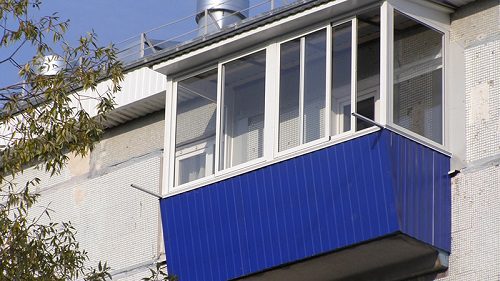
Material selection
There is a large selection of materials with high insulating properties. Unfortunately, not all types are suitable for external insulation of balconies. Experts advise choosing the following materials for these purposes.
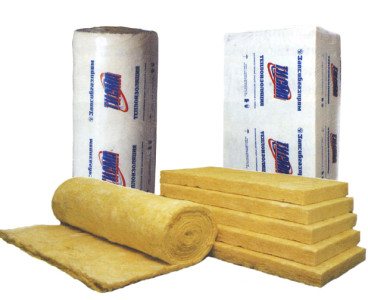
The use of mineral wool for external insulation of balconies is limited by the ability of the material to change thermal performance when wet. In addition, they refuse to use mineral wool due to inconvenient installation and the mandatory installation of sheathing.
Options for insulating a loggia with a ventilated facade
If a ventilated facade is installed on the balcony, there are at least two ways to insulate the room:
- All existing walls in the room are covered with plaster, after which foam insulation is installed using special glue. In turn, the insulation is sheathed with OSB boards, followed by a fine finishing.
This creates a warm air space indoors and a blowing wind outside the loggia windows. The advantages of this method include the simplicity of all finishing work. The disadvantages are that there is no complete guarantee that this option will work.
- The existing walls between the room and the loggia are completely dismantled. The material laid by the developers is replaced with a higher quality product from trusted manufacturers. The process ends, as in the first case, with finishing work.
If you have any doubts about insulating your loggia yourself, it is better to turn to specialists for help. Which option for insulating a loggia with a ventilated facade would you prefer?
Preparatory stage of work
Before starting work on insulating the parapet of a balcony (loggia) from the outside with your own hands, it is necessary to assess the volume of work to be done, the condition of the material from which the parapet is made, and calculate the cost of the work, taking into account the involvement of industrial climbers or the rental of special equipment. If the calculations received do not scare you and we are not talking about the price or the time spent on obtaining permission from regulatory authorities to make changes to the design and appearance of the building’s façade – then let’s get to work!
We have already written in an article dedicated to the difficulties associated with making changes to the external enclosing structure of a small balcony and the facade of a building. In addition to the lack of regulatory documents in Russian legislation that would provide for such a possibility and would make such insulation legal, it will also be necessary to coordinate the work with the owners of the apartment building, since the external walls and structures are the joint property of all owners of the apartment building.
Unauthorized changes entail not only dissatisfaction with neighbors, but the obligation to restore the façade structures to their previous form at your own expense. If you managed to obtain the necessary permits, then you can begin to carry out work.
